how to draw a line of best fit
Physics Practical Skills Function 4: Drawing graphs and lines of best fit
In role 4 of the Physics Skills Guide, nosotros explicate how to draw a line of all-time fit correctly in Physics Practicals. Read the mail to larn near dos and don'ts of drawing a line of best fit.
Introduction to Drawing Graphs and Lines of Best Fit
In this Guide, we explain the importance of scientific graphs in Physics and how to draw scientific graphs correctly including lines of best fit. This is a actually important Physics skill and you'll demand to master it if you lot want to ace your next Physics Practical exam.
In this commodity we discuss:
- Scientific graphs
- Drawing the line of all-time fit
- Common mistakes with cartoon lines of all-time fit
Want to ace your next Physics Practical Assessment?
Learn how to:
- Assess the validity, reliability and accurateness of any measurements and calculations
- Make up one's mind the sources of systematic and random errors
- Identify and apply appropriate mathematical formulae and concepts
- Draw appropriate graphs to convey relationships
with the Matrix Practical Skills Workbook.

Sharpen your Physics skills
Become test-ready for your Physics practical assessments with this free prac skills workbook.
Your workbook is on the way! Cheque your e-mail for the downloadable link. (Delight permit a few minutes for your download to land in your inbox)
DOWNLOAD YOUR Free PHYSICS WORKBOOK
Scientific Graphs
What are scientific graphs?
A graph is a visual representation of a relationship betwixt two variables, x (the independent variable) and y (the dependent variable).
Graphs make it easy to identify trends in data that you have nerveless and can be analysed in society to perform a adding or a measurement, related to addressing the aim of an experiment.
How to draw a scientific graph
| Footstep | Action | Detail |
| 1 | Identify the variables |
|
| two | Make up one's mind the variable range |
|
| 3 | Determine the scale of the graph |
|
| 4 | Number and label each axis |
|
| 5 | Plot the information points |
|
| 6 | Draw the graph |
|
| vii | Provide a descriptive championship |
|
In Year 11 and 12 Physics, the trends that you lot will investigate are mostly linear, or can be converted into linear graphs, and, hence, yous'll be required to draw a line of best fit.
Drawing the line of best fit
An example of a correctly drawn line of best fit is shown below, along with an incorrect one:
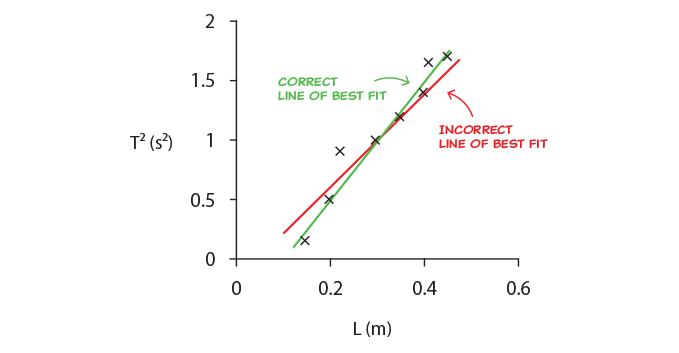
How to draw a line of best fit
To draw the line of best fit, consider the following:
- Outliers must exist ignored.
- The line must reverberate the trend in the data, i.e. information technology must line upward best with the majority of the information, and less with data points that differ from the majority.
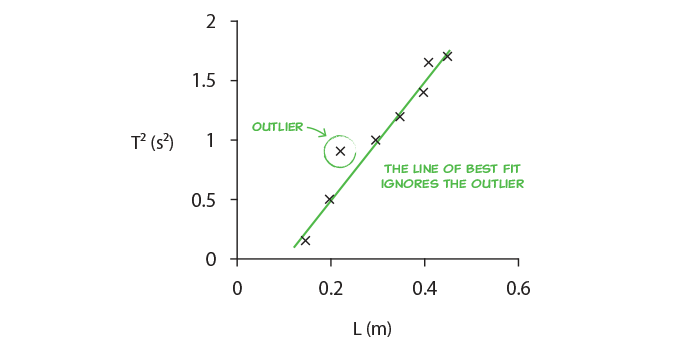
- The line must exist balanced, i.due east. it should have points above and beneath the line at both ends of the line.

- DO Not strength the line to pass through any specific data points, or to laissez passer through zero. The purpose of the line of best fit is to reveal the trend of all the data.
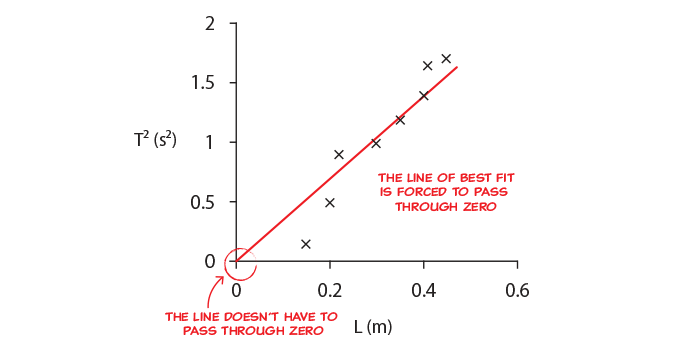
Why do we need to draw a line of best fit?
The main reasons for cartoon a line of all-time fit are to:
- Reduce the effect of both systematic and random error and thus make the experiment more authentic and more reliable.
- Find and use the slope of the line of best fit to determine an unknown in the experiment. Ordinarily determining this unknown addresses the aim in some fashion
How does the line of best fit reduce experimental errors?
Past drawing the line of all-time fit nosotros are looking for the strongest trend in the data, and in this fashion reduce the effect of random errors. If we and so apply the gradient of the line of best fit we expect at differences in values rather than absolute values, which reduces or eliminates the result of systematic errors.
The graphs below illustrate four examples with different types of errors and with no errors:
- Perfect data with no errors
- Random error
- Random error with outlier
- Random and systematic errors
The gradient represents the result of the experiment and should have a value of 1, so the equation of the line is \(y=ten\).
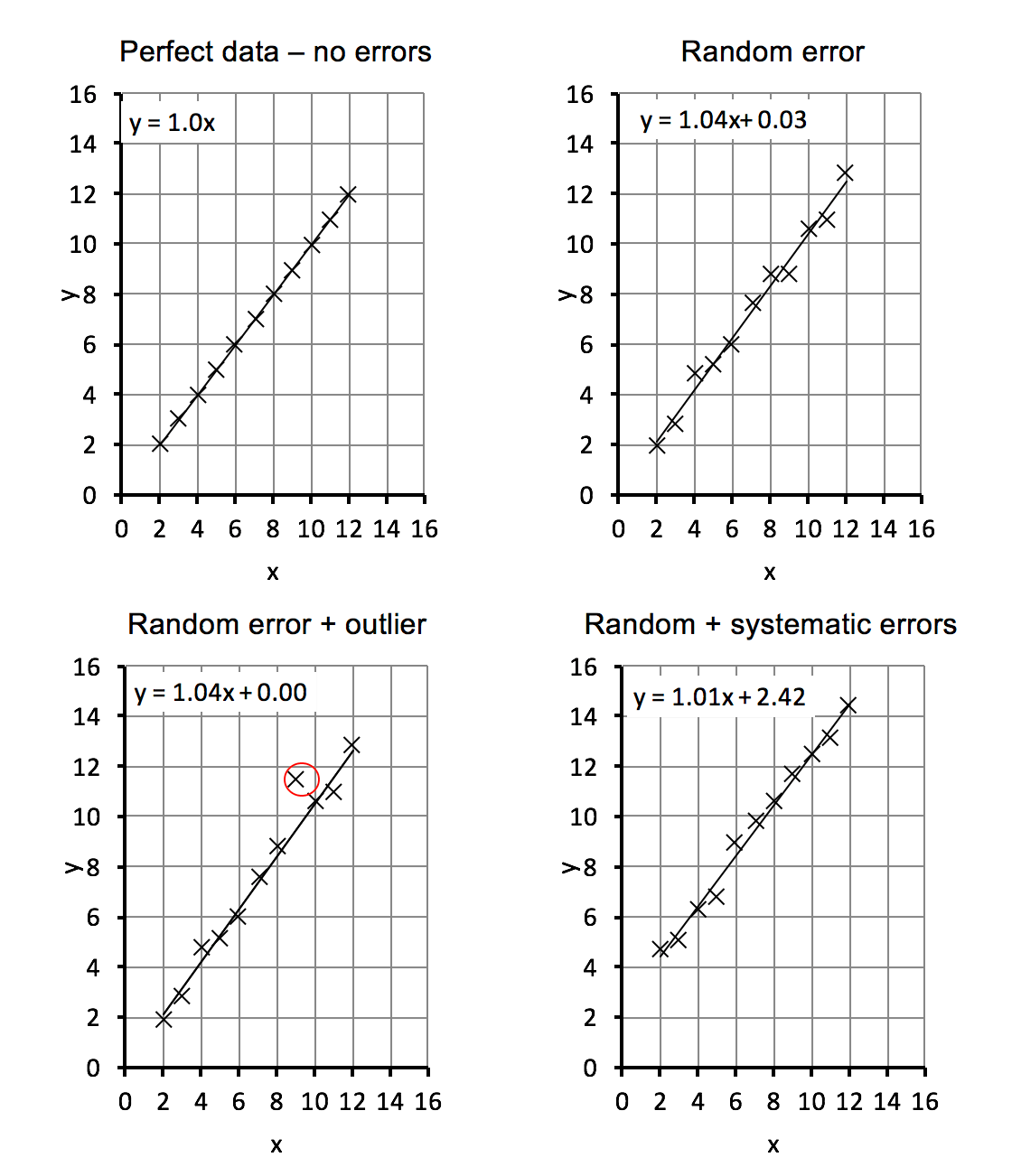
How does using a line of best fit reduce experimental errors?
Using a graph gives results that are equally good or better than calculating from the information points straight and then averaging, every bit shown in the table below.
| Types of error present | Outcome obtained from the slope of a line of best fit | Result obtained from calculating using all data points and averaging them |
| Perfect information – no errors | one.00 | 1.00 |
| Random mistake | one.04 | 1.04 |
| Random mistake with outlier | 1.04 | 1.07 |
| Random and systematic errors | 1.01 | 1.47 |
From the tabular array, we can see that:
- The perfect data has a gradient of 1.
- The random error gives a gradient is 1.04, still very close to the right value of i.
- The outlier is ignored by the line of best fit, so the gradient is still 1.04, close to the correct value. Averaging over the information points would not ignore the outlier and would give a worse result of ane.07.
- The systematic fault shifts up the data by the same amount just does not modify the slope, which is nonetheless 1.01. This is even so very close to the correct value of one.However, averaging over the points, in this instance, gives an incorrect answer of 1.47.
Mutual mistakes with cartoon lines of all-time fit
The example beneath shows common mistakes past students when cartoon lines of all-time fit. The exact mistakes the students have made are listed below.
Error 1: Missing labels
Graph i shown beneath is missing labels:
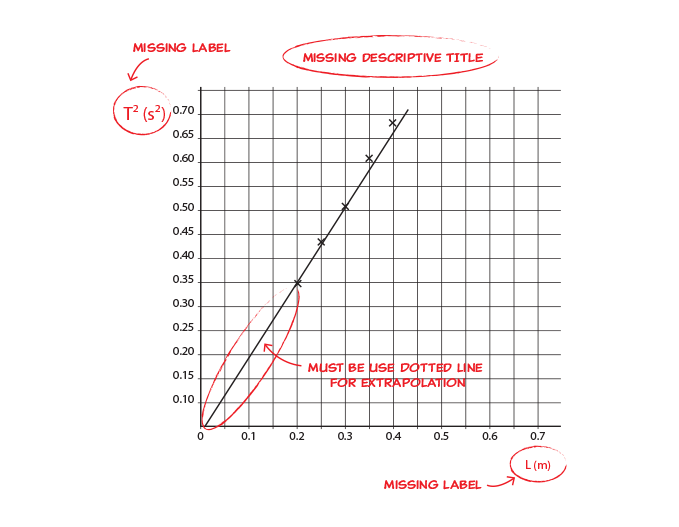
Mistakes in this graph include:
- Missing labels for the axes
- Missing descriptive championship
- The extrapolated line is not drawn using a dotted line
vi Mutual Mistakes HSC Physics Students Make in Exams
Mistake 2: Incorrect calibration
Graph ii shown below contains an incorrect scale:
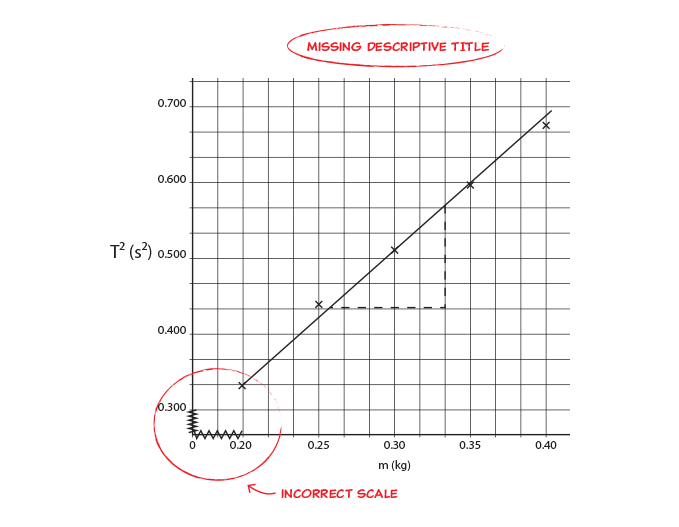
Mistakes in this graph include:
- Wrong scale in x and y-axes. Each division should stand for the same value across each centrality. For case, if each division is fix a value of 0.05 at the beginning of the graph for that axis, and then i division should always represent 0.05 for that centrality.
- The student should either start the scale at 0 or at 0.20 on the x-centrality.
© Matrix Education and www.matrix.edu.au, 2022. Unauthorised use and/or duplication of this cloth without express and written permission from this site's writer and/or owner is strictly prohibited. Excerpts and links may exist used, provided that full and clear credit is given to Matrix Education and www.matrix.edu.au with advisable and specific direction to the original content.
Source: https://www.matrix.edu.au/the-beginners-guide-to-physics-practical-skills/physics-practical-skills-part-4-how-to-draw-a-line-of-best-fit/
Posted by: lesherporwhou.blogspot.com


0 Response to "how to draw a line of best fit"
Post a Comment